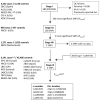A multi-stage genome-wide association study of bladder cancer identifies multiple susceptibility loci
- PMID: 20972438
- PMCID: PMC3049891
- DOI: 10.1038/ng.687
A multi-stage genome-wide association study of bladder cancer identifies multiple susceptibility loci
Abstract
We conducted a multi-stage, genome-wide association study of bladder cancer with a primary scan of 591,637 SNPs in 3,532 affected individuals (cases) and 5,120 controls of European descent from five studies followed by a replication strategy, which included 8,382 cases and 48,275 controls from 16 studies. In a combined analysis, we identified three new regions associated with bladder cancer on chromosomes 22q13.1, 19q12 and 2q37.1: rs1014971, (P = 8 × 10⁻¹²) maps to a non-genic region of chromosome 22q13.1, rs8102137 (P = 2 × 10⁻¹¹) on 19q12 maps to CCNE1 and rs11892031 (P = 1 × 10⁻⁷) maps to the UGT1A cluster on 2q37.1. We confirmed four previously identified genome-wide associations on chromosomes 3q28, 4p16.3, 8q24.21 and 8q24.3, validated previous candidate associations for the GSTM1 deletion (P = 4 × 10⁻¹¹) and a tag SNP for NAT2 acetylation status (P = 4 × 10⁻¹¹), and found interactions with smoking in both regions. Our findings on common variants associated with bladder cancer risk should provide new insights into the mechanisms of carcinogenesis.
Figures


References
-
- Silverman D, SS D, LE M, N R. Bladder Cancer. In: D S, Fraumeni JF Jr., editors. Cancer Epidemiology and Prevention. Oxford University Press; New York, NY: 2006. pp. 1101–1127.
-
- Kantor AF, Hartge P, Hoover RN, Fraumeni JF., Jr. Familial and environmental interactions in bladder cancer risk. Int J Cancer. 1985;35:703–6. - PubMed
-
- Murta-Nascimento C, et al. Risk of bladder cancer associated with family history of cancer: do low-penetrance polymorphisms account for the increase in risk? Cancer Epidemiol Biomarkers Prev. 2007;16:1595–600. - PubMed
-
- Aben KK, et al. Segregation analysis of urothelial cell carcinoma. Eur J Cancer. 2006;42:1428–33. - PubMed
Publication types
MeSH terms
Substances
Grants and funding
LinkOut - more resources
Full Text Sources
Other Literature Sources
Medical
Molecular Biology Databases
Research Materials
Miscellaneous

